
A | B | C | D | E | F | G | H | CH | I | J | K | L | M | N | O | P | Q | R | S | T | U | V | W | X | Y | Z | 0 | 1 | 2 | 3 | 4 | 5 | 6 | 7 | 8 | 9
This article needs additional citations for verification. (February 2021) |
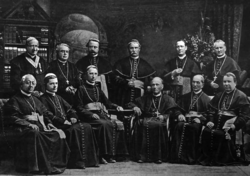
Clergy are formal leaders within established religions. Their roles and functions vary in different religious traditions, but usually involve presiding over specific rituals and teaching their religion's doctrines and practices. Some of the terms used for individual clergy are clergyman, clergywoman, clergyperson, churchman, cleric, ecclesiastic, and vicegerent while clerk in holy orders has a long history but is rarely used.[citation needed]
In Christianity, the specific names and roles of the clergy vary by denomination and there is a wide range of formal and informal clergy positions, including deacons, elders, priests, bishops, preachers, pastors, presbyters, ministers, and the pope.
In Islam, a religious leader is often known formally or informally as an imam, caliph, qadi, mufti, mullah, muezzin and ulema.
In the Jewish tradition, a religious leader is often a rabbi (teacher) or hazzan (cantor).
Etymology
The word cleric comes from the ecclesiastical Latin Clericus, for those belonging to the priestly class. In turn, the source of the Latin word is from the Ecclesiastical Greek Klerikos (κληρικός), meaning appertaining to an inheritance, in reference to the fact that the Levitical priests of the Old Testament had no inheritance except the Lord.[1] "Clergy" is from two Old French words, clergié and clergie, which refer to those with learning and derive from Medieval Latin clericatus, from Late Latin clericus (the same word from which "cleric" is derived).[2] "Clerk", which used to mean one ordained to the ministry, also derives from clericus. In the Middle Ages, reading and writing were almost exclusively the domain of the priestly class, and this is the reason for the close relationship of these words.[3] Within Christianity, especially in Eastern Christianity and formerly in Western Roman Catholicism, the term cleric refers to any individual who has been ordained, including deacons, priests, and bishops.[4] In Latin Catholicism, the tonsure was a prerequisite for receiving any of the minor orders or major orders before the tonsure, minor orders, and the subdiaconate were abolished following the Second Vatican Council.[5] Now, the clerical state is tied to reception of the diaconate.[6] Minor Orders are still given in the Eastern Catholic Churches, and those who receive those orders are 'minor clerics.'[7]
The use of the word cleric is also appropriate for Eastern Orthodox minor clergy who are tonsured in order not to trivialize orders such as those of Reader in the Eastern Church, or for those who are tonsured yet have no minor or major orders. It is in this sense that the word entered the Arabic language, most commonly in Lebanon from the French, as kleriki (or, alternatively, cleriki) meaning "seminarian." This is all in keeping with Eastern Orthodox concepts of clergy, which still include those who have not yet received, or do not plan to receive, the diaconate.
A priesthood is a body of priests, shamans, or oracles who have special religious authority or function. The term priest is derived from the Greek presbyter (πρεσβύτερος, presbýteros, elder or senior), but is often used in the sense of sacerdos in particular, i.e., for clergy performing ritual within the sphere of the sacred or numinous communicating with the gods on behalf of the community.
Buddhism
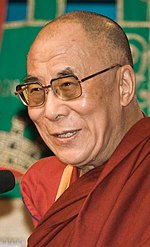
Buddhist clergy are often collectively referred to as the Sangha, and consist of various orders of male and female monks (originally called bhikshus and bhikshunis respectively). This diversity of monastic orders and styles was originally one community founded by Gautama Buddha during the 5th century BC living under a common set of rules (called the Vinaya). According to scriptural records, these celibate monks and nuns in the time of the Buddha lived an austere life of meditation, living as wandering beggars for nine months out of the year and remaining in retreat during the rainy season (although such a unified condition of Pre-sectarian Buddhism is questioned by some scholars). However, as Buddhism spread geographically over time – encountering different cultures, responding to new social, political, and physical environments – this single form of Buddhist monasticism diversified. The interaction between Buddhism and Tibetan Bon led to a uniquely Tibetan Buddhism, within which various sects, based upon certain teacher-student lineages arose. Similarly, the interaction between Indian Buddhist monks (particularly of the Southern Madhyamika School) and Chinese Confucian and Taoist monks from c200-c900AD produced the distinctive Ch'an Buddhism. Ch'an, like the Tibetan style, further diversified into various sects based upon the transmission style of certain teachers (one of the most well known being the 'rapid enlightenment' style of Linji Yixuan), as well as in response to particular political developments such as the An Lushan Rebellion and the Buddhist persecutions of Emperor Wuzong. In these ways, manual labour was introduced to a practice where monks originally survived on alms; layers of garments were added where originally a single thin robe sufficed; etc. This adaptation of form and roles of Buddhist monastic practice continued after the transmission to Japan. For example, monks took on administrative functions for the Emperor in particular secular communities (registering births, marriages, deaths), thereby creating Buddhist 'priests'. Again, in response to various historic attempts to suppress Buddhism (most recently during the Meiji Era), the practice of celibacy was relaxed and Japanese monks allowed to marry. This form was then transmitted to Korea, during later Japanese occupation,[8] where celibate and non-celibate monks today exist in the same sects. (Similar patterns can also be observed in Tibet during various historic periods multiple forms of monasticism have co-existed such as "ngagpa" lamas, and times at which celibacy was relaxed). As these varied styles of Buddhist monasticism are transmitted to Western cultures, still more new forms are being created.
In general, the Mahayana schools of Buddhism tend to be more culturally adaptive and innovative with forms, while Theravada schools (the form generally practised in Thailand, Burma, Cambodia and Sri Lanka) tend to take a much more conservative view of monastic life, and continue to observe precepts that forbid monks from touching women or working in certain secular roles. This broad difference in approach led to a major schism among Buddhist monastics in about the 4th century BCE, creating the Early Buddhist Schools.
While female monastic (bhikkhuni) lineages existed in most Buddhist countries at one time, the Theravada lineages of Southeast Asia died out during the 14th-15th Century AD. As there is some debate about whether the bhikkhuni lineage (in the more expansive Vinaya forms) was transmitted to Tibet, the status and future of female Buddhist clergy in this tradition is sometimes disputed by strict adherents to the Theravadan style. Some Mahayana sects, notably in the United States (such as San Francisco Zen Center) are working to reconstruct the female branches of what they consider a common, interwoven lineage.[9]
The diversity of Buddhist traditions makes it difficult to generalize about Buddhist clergy. In the United States, Pure Land priests of the Japanese diaspora serve a role very similar to Protestant ministers of the Christian tradition. Meanwhile, reclusive Theravada forest monks in Thailand live a life devoted to meditation and the practice of austerities in small communities in rural Thailand- a very different life from even their city-dwelling counterparts, who may be involved primarily in teaching, the study of scripture, and the administration of the nationally organized (and government sponsored) Sangha. In the Zen traditions of China, Korea and Japan, manual labor is an important part of religious discipline; meanwhile, in the Theravada tradition, prohibitions against monks working as laborers and farmers continue to be generally observed.
Currently in North America, there are both celibate and non-celibate clergy in a variety of Buddhist traditions from around the world. In some cases they are forest dwelling monks of the Theravada tradition and in other cases they are married clergy of a Japanese Zen lineage and may work a secular job in addition to their role in the Buddhist community. There is also a growing realization that traditional training in ritual and meditation as well as philosophy may not be sufficient to meet the needs and expectations of American lay people. Some communities have begun exploring the need for training in counseling skills as well. Along these lines, at least two fully accredited Master of Divinity programs are currently available: one at Naropa University in Boulder, CO and one at the University of the West in Rosemead, CA.
Titles for Buddhist clergy include:
In Theravada:
- Acharya
- Ajahn
- Anagarika
- Ayya
- Bhante
- Dasa sil mata
- Luang Por
- Maechi or Mae chee
- Phra
- Sayadaw
- Sikkhamānā
- Thilashin
In Mahayana:
In Vajrayana:
Christianity
In general, Christian clergy are ordained; that is, they are set apart for specific ministry in religious rites. Others who have definite roles in worship but who are not ordained (e.g. laypeople acting as acolytes) are generally not considered clergy, even though they may require some sort of official approval to exercise these ministries.
Types of clerics are distinguished from offices, even when the latter are commonly or exclusively occupied by clerics. A Roman Catholic cardinal, for instance, is almost without exception a cleric, but a cardinal is not a type of cleric. An archbishop is not a distinct type of cleric, but is simply a bishop who occupies a particular position with special authority. Conversely, a youth minister at a parish may or may not be a cleric. Different churches have different systems of clergy, though churches with similar polity have similar systems.
Anglicanism
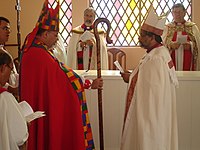
In Anglicanism, clergy consist of the orders of deacons, priests (presbyters) and bishops in ascending order of seniority. Canon, archdeacon, archbishop and the like are specific positions within these orders. Bishops are typically overseers, presiding over a diocese composed of many parishes, with an archbishop presiding over a province in most, which is a group of dioceses. A parish (generally a single church) is looked after by one or more priests, although one priest may be responsible for several parishes. New clergy are first ordained as deacons. Those seeking to become priests are usually ordained to the priesthood around a year later. Since the 1960s some Anglican churches have reinstituted the permanent diaconate, in addition to the transitional diaconate, as a ministry focused on bridges the church and the world, especially ministry to those on the margins of society.
For a short period of history before the ordination of women as deacons, priests and bishops began within Anglicanism, women could be deaconesses. Although they were usually considered having a ministry distinct from deacons they often had similar ministerial responsibilities.
In Anglicanism all clergy are permitted to marry. In most national churches women may become deacons or priests, but while fifteen out of 38 national churches allow for the consecration of women as bishops, only five have ordained any. Celebration of the Eucharist is reserved for priests and bishops.
National Anglican churches are presided over by one or more primates or metropolitans (archbishops or presiding bishops). The senior archbishop of the Anglican Communion is the Archbishop of Canterbury, who acts as leader of the Church of England and 'first among equals' of the primates of all Anglican churches.
Being a deacon, priest or bishop is considered a function of the person and not a job. When priests retire they are still priests even if they no longer have any active ministry. However, they only hold the basic rank after retirement. Thus a retired archbishop can only be considered a bishop (though it is possible to refer to "Bishop John Smith, the former Archbishop of York"), a canon or archdeacon is a priest on retirement and does not hold any additional honorifics.
For the forms of address for Anglican clergy, see Forms of address in the United Kingdom.
-
Sir George Fleming, 2nd Baronet, British churchman.
-
Charles Wesley Leffingwell, Episcopal priest
Baptist
The Baptist tradition only recognizes two ordained positions in the church as being the elders (pastors) and deacons as outlined in the third chapter of I Timothy[10] in the Bible.
Catholic Church
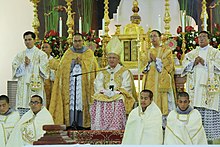
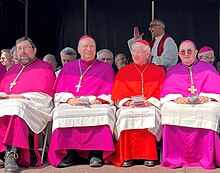
Ordained clergy in the Catholic Church are either deacons, priests, or bishops belonging to the diaconate, the presbyterate, or the episcopate, respectively. Among bishops, some are metropolitans, archbishops, or patriarchs. The pope is the bishop of Rome, the supreme and universal hierarch of the Church, and his authorization is now required for the ordination of all Roman Catholic bishops. With rare exceptions, cardinals are bishops, although it was not always so; formerly, some cardinals were people who had received clerical tonsure, but not Holy Orders. Secular clergy are ministers, such as deacons and priests, who do not belong to a religious institute and live in the world at large, rather than a religious institute (saeculum). The Holy See supports the activity of its clergy by the Congregation for the Clergy (), a dicastery of Roman curia.
Canon Law indicates (canon 207) that "y divine institution, there are among the Christian faithful in the Church sacred ministers who in law are also called clerics; the other members of the Christian faithful are called lay persons".[11] This distinction of a separate ministry was formed in the early times of Christianity; one early source reflecting this distinction, with the three ranks or orders of bishop, priest and deacon, is the writings of Saint Ignatius of Antioch.
Holy Orders is one of the Seven Sacraments, enumerated at the Council of Trent, that the Magisterium considers to be of divine institution. In the Catholic Church, only men are permitted to be clerics.[citation needed]
In the Latin Church before 1972, tonsure admitted someone to the clerical state, after which he could receive the four minor orders (ostiary, lectorate, order of exorcists, order of acolytes) and then the major orders of subdiaconate, diaconate, presbyterate, and finally the episcopate, which according to Roman Catholic doctrine is "the fullness of Holy Orders". Since 1972 the minor orders and the subdiaconate have been replaced by lay ministries and clerical tonsure no longer takes place, except in some Traditionalist Catholic groups, and the clerical state is acquired, even in those groups, by Holy Orders.[12] In the Latin Church the initial level of the three ranks of Holy Orders is that of the diaconate. In addition to these three orders of clerics, some Eastern Catholic, or "Uniate", Churches have what are called "minor clerics".[13]
Members of institutes of consecrated life and societies of apostolic life are clerics only if they have received Holy Orders. Thus, unordained monks, friars, nuns, and religious brothers and sisters are not part of the clergy.
The Code of Canon Law and the Code of Canons of the Eastern Churches prescribe that every cleric must be enrolled or "incardinated" in a diocese or its equivalent (an apostolic vicariate, territorial abbey, personal prelature, etc.) or in a religious institute, society of apostolic life or secular institute.[14][13] The need for this requirement arose because of the trouble caused from the earliest years of the Church by unattached or vagrant clergy subject to no ecclesiastical authority and often causing scandal wherever they went.[15]
Current canon law prescribes that to be ordained a priest, an education is required of two years of philosophy and four of theology, including study of dogmatic and moral theology, the Holy Scriptures, and canon law have to be studied within a seminary or an ecclesiastical faculty at a university.[16][17]
Clerical celibacy is a requirement for almost all clergy in the predominant Latin Church, with the exception of deacons who do not intend to become priests. Exceptions are sometimes admitted for ordination to transitional diaconate and priesthood on a case-by-case basis for married clergymen of other churches or communities who become Catholics, but consecration of already married men as bishops is excluded in both the Latin and Eastern Catholic Churches (see personal ordinariate). Clerical marriage is not allowed and therefore, if those for whom in some particular Church celibacy is optional (such as permanent deacons in the Latin Church) wish to marry, they must do so before ordination. Eastern Catholic Churches while allowing married men to be ordained, do not allow clerical marriage after ordination: their parish priests are often married, but must marry before being ordained to the priesthood.[18] Eastern Catholic Churches require celibacy only for bishops.
Eastern Orthodoxy
| Part of a series on the |
| Eastern Orthodox Church |
|---|
| Overview |
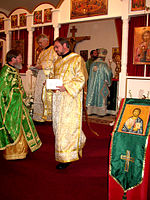
The Eastern Orthodox Church has three ranks of holy orders: bishop, priest, and deacon. These are the same offices identified in the New Testament and found in the Early Church, as testified by the writings of the Holy Fathers. Each of these ranks is ordained through the Sacred Mystery (sacrament) of the laying on of hands (called cheirotonia) by bishops. Priests and deacons are ordained by their own diocesan bishop, while bishops are consecrated through the laying on of hands of at least three other bishops.
Within each of these three ranks there are found a number of titles. Bishops may have the title of archbishop, metropolitan, and patriarch, all of which are considered honorifics. Among the Orthodox, all bishops are considered equal, though an individual may have a place of higher or lower honor, and each has his place within the order of precedence. Priests (also called presbyters) may (or may not) have the title of archpriest, protopresbyter (also called "protopriest", or "protopope"), hieromonk (a monk who has been ordained to the priesthood) archimandrite (a senior hieromonk) and hegumen (abbot). Deacons may have the title of hierodeacon (a monk who has been ordained to the deaconate), archdeacon or protodeacon.
The lower clergy are not ordained through cheirotonia (laying on of hands) but through a blessing known as cheirothesia (setting-aside). These clerical ranks are subdeacon, reader and altar server (also known as taper-bearer). Some churches have a separate service for the blessing of a cantor.
Ordination of a bishop, priest, deacon or subdeacon must be conferred during the Divine Liturgy (Eucharist)—though in some churches it is permitted to ordain up through deacon during the Liturgy of the Presanctified Gifts—and no more than a single individual can be ordained to the same rank in any one service. Numerous members of the lower clergy may be ordained at the same service, and their blessing usually takes place during the Little Hours prior to Liturgy, or may take place as a separate service. The blessing of readers and taper-bearers is usually combined into a single service. Subdeacons are ordained during the Little Hours, but the ceremonies surrounding his blessing continue through the Divine Liturgy, specifically during the Great Entrance.
Bishops are usually drawn from the ranks of the archimandrites, and are required to be celibate; however, a non-monastic priest may be ordained to the episcopate if he no longer lives with his wife (following Canon XII of the Quinisext Council of Trullo)[19] In contemporary usage such a non-monastic priest is usually tonsured to the monastic state, and then elevated to archimandrite, at some point prior to his consecration to the episcopacy. Although not a formal or canonical prerequisite, at present bishops are often required to have earned a university degree, typically but not necessarily in theology.
Usual titles are Your Holiness for a patriarch (with Your All-Holiness reserved for the Ecumenical Patriarch of Constantinople), Your Beatitude for an archbishop/metropolitan overseeing an autocephalous Church, Your Eminence for an archbishop/metropolitan generally, Master or Your Grace for a bishop and Father for priests, deacons and monks,[20] although there are variations between the various Orthodox Churches. For instance, in Churches associated with the Greek tradition, while the Ecumenical Patriarch is addressed as "Your All-Holiness", all other Patriarchs (and archbishops/metropolitans who oversee autocephalous Churches) are addressed as "Your Beatitude".[21]
Zdroj:https://en.wikipedia.org?pojem=Spiritual_leader
Text je dostupný za podmienok Creative Commons Attribution/Share-Alike License 3.0 Unported; prípadne za ďalších podmienok. Podrobnejšie informácie nájdete na stránke Podmienky použitia.
Antropológia
Aplikované vedy
Bibliometria
Dejiny vedy
Encyklopédie
Filozofia vedy
Forenzné vedy
Humanitné vedy
Knižničná veda
Kryogenika
Kryptológia
Kulturológia
Literárna veda
Medzidisciplinárne oblasti
Metódy kvantitatívnej analýzy
Metavedy
Metodika
Text je dostupný za podmienok Creative
Commons Attribution/Share-Alike License 3.0 Unported; prípadne za ďalších
podmienok.
Podrobnejšie informácie nájdete na stránke Podmienky
použitia.
www.astronomia.sk | www.biologia.sk | www.botanika.sk | www.dejiny.sk | www.economy.sk | www.elektrotechnika.sk | www.estetika.sk | www.farmakologia.sk | www.filozofia.sk | Fyzika | www.futurologia.sk | www.genetika.sk | www.chemia.sk | www.lingvistika.sk | www.politologia.sk | www.psychologia.sk | www.sexuologia.sk | www.sociologia.sk | www.veda.sk I www.zoologia.sk



